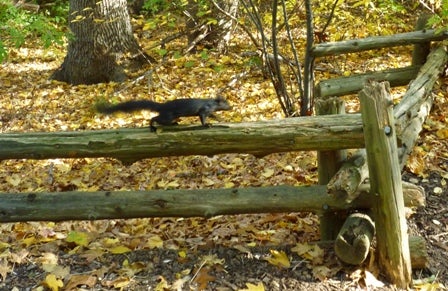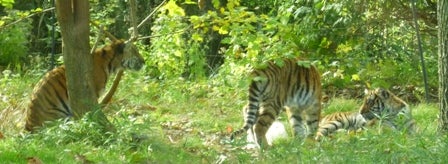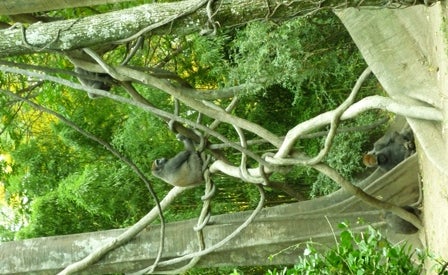Oberlin Blogs
New York, New York: Tiger Cubs and Wooden Escalators
October 29, 2010
Tess Yanisch ’13
Those of you who read my last entry already know that I'm in New York for fall break. My adventures have continued nonstop these past few days! Here they are in a nutshell.
On Monday, Guy and I went to the aquarium. That was a lot of fun; however, I didn't take pictures there, so I'm going to gloss over it. The one thing I would like to bring to everyone's attention is the long-horned cowfish. It looks like it should be a stylized drawing in a picture book, not a real animal.
Tuesday was Tourist Day: I saw pretty much everything you're "supposed to" see in New York in one busy, fantastic day. Guy and I got to the Empire State Building around 8:30 in the morning. We'd gotten tickets in advance to help avoid lines--the Internet is a useful thing--but there were hardly any lines to speak of! I don't think we waited anywhere longer than a minute. Granted, it was a weekday morning in late October, but still. This is apparently almost as unheard-of as waltzing into Disneyland and getting right on Space Mountain.

The view was incredible. It was slightly foggy over the rivers, but clear and breezy on the observation deck. There was a cloud just over the very top of the building. (Apparently that's a dirigible dock; it was only used once, because it turns out to be very dangerous to dock a flying bag of gas on the top of a skyscraper surrounded by other skyscrapers--geez, who'da thunk?)
Looking South (I think):

Everything directly below the Empire State Building looks tiny. Those "little short buildings" are actually about ten stories tall.

.

.

.

Looking toward Queens:
The lonely skyscraper across the river is the Citibank building, Queens' only skyscraper.

I think this is the north view:

(What the heck is this ridiculously ornate building? Guy didn't know.)

And, finally, looking west:

After that, we headed over to the original Macy's department store.
I'm sure you're asking, "Tess, why on Earth would you go to New York City only to go shopping in a national chain? And why do this in the morning, when you'd have to carry your purchases around all day?"
Well, silly, we weren't going to actually buy anything. Guy's mom had mentioned that Macy's still had some of its original wooden escalators, and that was a sight worth seeing.
The Empire State Building went so smoothly and quickly that we actually had to wait fifteen minutes for the store to open. We passed the time by looking at nearby statues, including this one, which used to stand over the New York Herald.

While we were looking at it, a man came up and admired it with us. He told us that it was very special to him, because the large figure in the center is Minerva, and "I'm one of the last believers in the Roman gods and goddesses." I didn't know people still worshiped them...
We got into Macy's and, after a few minutes of wandering, found a functioning wooden escalator. It was everything I'd hoped. I forgot to take a photo, but there are pictures and even videos already out there--just Google it. We went down one and up its twin, and then headed back outside. Next stop: Grand Central.
I also don't have any pictures of that, but it was truly incredible. There were more Roman gods on the outside--Minerva again, with Hercules and Mercury: innovation, strength, and travel. Half the Zodiac is painted on the ceiling of the main concourse--I wonder if the rest are somewhere else.
Then we caught a train to the Staten Island Ferry. We went over to Staten Island, then turned around and went straight back.

New York Harbor.

.

.

From the ferry, you can see the harbor, the Manhattan skyline, lots of bridges, seagulls coasting alongside, and a certain giant statue . . .

.

.

You see, this is much easier and cheaper than going to Ellis Island. You get a good look at the Statue of Liberty--the ferry comes very close. I was too busy looking in real life to take pictures when we were closest, but trust me, it's great.
After the ferry, we went to the memorial construction site at ground zero, and then to Central Park.

.

There was a man blowing giant bubbles.

.

.

After much meandering, we found the statue of Balto. (Who else loved that movie as a kid? Hands?)

From Central Park, we went to find a place to eat dinner, encountering some hug-happy Muppets along the way.

And after dinner, we went to see Billy Elliot: The Musical. That was mind-blowing. My favorite song was called "Solidarity" and it had fantastic choreography; there was also a dream-sequence Swan Lake dance that had me literally slack-jawed in amazement. Please note that the star of this show was twelve years old.
On Wednesday, Guy and I went to one of his favorite places: the Museum of Natural History. It is now one of my favorite places as well.
We began with the Hall of Human Origins, looking at the pieces of humanity's evolutionary history. We've discovered so much, and corrected so many false conclusions (modern humans aren't directly descended from Neanderthals or from Homo erectus), but there's still so much we don't know: why did other species die off when our ancestors didn't? Neanderthals, for instance, were thriving; did early modern humans somehow out-compete them?
One of the ideas that I found particularly intriguing is that it's related to our creative abilities and capacity for abstract thinking: Neanderthals had no art and no apparent death rituals. (They did bury their dead, but that could have been strictly a practical concern.) Does our imagination have that much of an effect? Studying that would make me, as a social scientist, very happy. There was a whole section of the exhibit devoted to the development of culture and comparing human art, music, and socialization to that of other species. It was fantastic.
From there, we wandered through other, older exhibits. Guy showed me a section of a giant sequoia that had been over 1,300 years old when it was cut down. I knew, conceptually, that trees that big and that old exist, but actually seeing one makes it more real somehow.
Guy had me close my eyes before we went into the next exhibit. He steered me up against a railing, then told me to look. I found myself staring out at a life-sized model of a blue whale.
What was I saying about the reality of big things . . . ?
After we'd completed a circuit of the ocean life exhibit, we headed for one called "Scales of the Universe." This exhibit required the addition of a new wing to the museum. In the center is a vast globe, called the Hayden Globe. A path wraps around it. On the railings of the path are descriptions of size, going by powers of ten. At most levels there are objects used for frames of reference when considering relative size. For instance, "If the sun were the size of the Hayden Globe, the planets would be this big."
It took a couple of dramatic scale decreases before the numbers started to mean anything, even so--in the first comparison, the Hayden Globe represents the entire universe. When we got down to a scale on which the Milky Way was visible, I began to have some faint inkling of how vast the previous levels must have been. When we got to the Oort cloud, a bunch of comets that I tend to think of as the backyard fence of our solar system, I was amazed at how much there was left to go. It's a big backyard. No, check that, it's a fucking huge backyard.
The Museum of Natural History had discounted Pluto's planet-status even when this exhibit came out, several years before it was officially demoted. Looking at this, you can see why. If I recall correctly, it's literally not even on the same scale as the other planets--it had to be compared to something else before it even showed up.
Guy, incidentally, was narrating all these in true tour-guide style. I'd advise everyone to visit New York with a knowledgeable, enthusiastic friend who enjoys spreading the enthusiasm around.
Eventually, of course, we got down to a 1:1 scale: "If the Hayden Globe were the size of the Hayden Globe, the human brain would be the size of a human brain." Nice, simple, and easy to handle.
Then it slips into negative powers. "If the human brain were the size of the Hayden Globe, a drop of rain would be this big." And from there . . . red blood cells; viruses, so tiny no one's sure if they're really alive; hydrogen atoms; protons; electrons. Again, you can conceptualize something, but the enormous amount of space between the nucleus and the electron cloud is something that only a giant model can really bring home. And the size difference between a proton and an electron is considerably larger than any textbook drawing can hope to capture.
After lunch, we wandered through most of the rest of the museum. I still have an eight-year-old's compulsion to look at dinosaur bones, and I don't think I'd ever seen mammoth skeletons before. Then samplings of the different world cultural exhibits, and then . . Then we were kinda tired, actually.
But we visited the Strand before calling it a day.
On Thursday, Guy and I visited the Bronx Zoo. We saw all kinds of rare and exotic wildlife, like gorillas and tigers and a red panda and a snow leopard and . . . the most exciting animal of all . . .

Black squirrels are apparently native here. I don't think I'd ever seen one before. That counts!
Seriously, though, we saw so many animals. My favorites were probably the big cats.

The tigers and lions were particularly fun because they had cubs! Two kinds of tiger cubs, in fact--Amur and Malayan--both litters about five months old.
The two Amur cubs were bigger and fuzzier. They were the ones we saw first, and for a while I thought I'd have to ask Guy to take the pictures because I was incapable of doing anything but stand there in awwwwww. (My practical and efficient nature has no defense against young felines being adorable.)

.

.

.

There were three Malayan cubs. These guys had a fishcicle, a big block of ice with fish treats frozen into it. One of them in particular kept licking/biting/sticking his head into it, trying to get them out.

.

.

.

The lion cubs were older, I think. We got to their exhibit just before they went inside for the night. There were three young cubs, one older sibling, and their mother.

.

.

.

.

We also saw panthers.

Note how intent they are. You see, the exhibit across from them was supposed to contain a tapir, but it was gone for some reason. The peafowl that also lived in that exhibit had taken the opportunity to hop out and start wandering around.

Guy was displeased. Irate, even . . .

. . . Imploring . . .

. . . Despairing.

You can only see one in these pictures, but there were two of them wandering around in the branches above the exhibit. They were very lucky all those panthers could do was watch!
That wasn't even the only amusing bird episode of the day. Earlier, we'd witnessed a regular peacock trying to enter the monkey house. (Peacocks wander at will around the zoo.)

Of course, the famous gorilla exhibit was impressive too.

.

.

.

.

.

The Bronx Zoo's gorilla breeding program has apparently been highly successful. Actually, all of its breeding programs appear to be highly successful. This is a great zoo.
Here are some more pictures of animals, just because:

.

.

.


.

So ends my most recent installment. Coming soon: reports from the Rally to Restore Sanity!
Similar Blog Entries

Stockholm Memories
March 31, 2025
These moments, where the marvelous and the everyday meet, are a serendipity I didn’t know I was missing.

Springtime Quad Revival
March 21, 2025
Warm weather can always be detected by Obies spreading throughout the fields and quads of campus, soaking in the sunshine.
